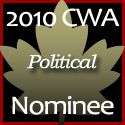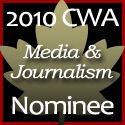 It's interesting when you research the roots of the Reform Party of Canada (now calling themselves the Conservative Party of Canada), how much they really believe that women's rights have helped to destroy their country.
It's interesting when you research the roots of the Reform Party of Canada (now calling themselves the Conservative Party of Canada), how much they really believe that women's rights have helped to destroy their country.Not alone naturally. Their other pet peeves are non-whites, homosexuality and Human Rights Commissions.
Most of their grievances, however, are now being channelled through the Religious Right, who have not only found a voice in the Harper government, but also legitimacy.
I recently stumbled across a book review for Michael Wagner's Standing on Guard for Thee: The Past, Present and Future of Canada’s Christian Right, that helped to sum up the movement.
The reviewer Michael Valpy, suggests that perhaps moderating their message to adapt to mainstream Canadians would be far more effective than simply trying to force these beliefs on a nation that does not share their goals.
The endorsements on the book jacket also reveal further ties to the Harper Government. Link Byfield, REAL Women and Tristan Emmanuel of Equipping Christians for the Public Square. All, with the exception of Tristan Emmanuel, helped to form the Northern Foundation, that originally fought against the end of apartheid in South Africa, but eventually became part of a 'white brotherhood' movement. Then of course the mention of William Gairdner, another NF founder, whose book The Trouble With Canada, helped lay the groundwork for Reform Party policy.
The Noisy Christian Right
In this country, it seems, we really do like our religion kept private.
By Michael Valpy
September 1, 2008
(Standing on Guard for Thee: The Past, Present and Future of Canada’s Christian Right Michael Wagner Freedom Press 274 pages, hardcover ISBN 9780973275773)
What is startling about reading Michael Wagner’s valuable, original account of the Christian Right in Canada in Standing on Guard for Thee: The Past, Present and Future of Canada’s Christian Right is the realization that, from the inside, where Wagner is, it is a really hard place to be. Indeed, what he reveals is the existence of two fundamentally opposed narratives about conservative Christianity in this country.
From the outside looking in — that is, from prevailing news media accounts and alarmist secular warnings overly influenced, I believe, by what is happening south of the border — the Christian Right is presented as an increasingly muscular and well-organized force, holding the ear of the Conservative parliamentary caucus and some of its ministers, its hand poised to turn off the federal tap for funding inappropriate films, skillfully battling for “family values only” books in school libraries and keeping alive campaigns against abortion and homosexual marriage.
Yet from the inside looking out, the Canada that Wagner shows us is the Canada that most sociologists of religion say exists: a country far more a part of the spiritual cold belt of western Europe than of the hot flashes of America’s current Great Awakening, and a country whose history of the past half-century, in the words of one testimonial writer for Wagner’s book, has been “a gore-filled account of … spiritual decline,” in which the Christian Right has experienced unmitigated failure in promoting its agenda.
In Wagner, a more supportive chronicler the Christian Right could not hope to find: an Edmonton freelance writer with a Ph.D. in political science from University of Alberta who has home-schooled his nine children. He has endorsements on his book jacket from a pantheon of the Christian Right: the powerfully articulate editor and writer (and Alberta senator-in-waiting) Link Byfield, REAL Women’s Gwendolyn Landolt and Tristan Emmanuel of Equipping Christians for the Public Square.
Wagner has not written a scholarly book. He has not written a book that could be said to meet standards of good journalistic analysis, setting events in historic context and perspective. I don’t think that flaws it a whole lot, because what he has written is an exceptionally useful and interesting book, a detailed compilation of the Christian Right’s activities since the 1960s seen through the movement’s own lens that allows the reader to feel what the Christian Right’s leading activists have felt over the past half-century and to have a glimpse into their minds without mediation by some scholar’s or journalist’s filters.
He begins with a definition of the Christian Right that is satisfactory: “A collection of people, organizations and publications which, because of their conservative Christian principles, are determined to oppose the effects of the Sexual Revolution [his capital letters]. Many of these people, organizations and publications are evangelicals in their outlook and theology, but others are not. Thus the Christian Right in Canada should not be confused with the broader evangelical Christian community” — a very important distinction to make.
If his label still seems ambiguous, it is because a major difficulty with defining and understanding not only the Christian Right but all religious behaviour in Canada lies with the dearth of academic study of the subject outside the depressingly underfunded work of a handful of scholars such as Reginald Bibby, David Seljak, Peter Beyer, Jean-Philippe Warren and Solange Lefebvre (and any others to whom I apologize for omitting). Religion is not a subject that interests Canada’s academic granting agencies.
Wagner catalogues five decades of defeat on the battlefields of feminism, the sexual revolution, abortion and homosexuality. He records how, time and again, the hopes of the Canadian Christian Right are raised only to be dashed. Conservative Brian Mulroney turns out to be as socially liberal as Pierre Trudeau. The few lower court decisions that support the Christian Right’s causes invariably get overturned on appeal. The rise of human rights commissions created by federal and provincial legislation blunt the movement’s campaign against homosexual rights.
The immensely popular Charter of Rights and Freedoms enacted in 1982 turns out to be the constitutional entrenchment of the Antichrist. Preston Manning, Alberta’s founding force of the conservative Reform Party, is a disappointment. Christian social conservatives are shocked to learn that two thirds of delegates to the Reform Party’s 1992 national assembly respond to a questionnaire by saying they believe abortion is a private matter of choice between a woman and her doctor. (I'm shocked to learn that as well. So why are the reform MPs so intent on taking away a woman's right to choose?)
In Stockwell Day, conservative Christians feel they have found their man but he is almost cruelly laughed out of office as leader of the Canadian Alliance. Ralph Klein lets them down by refusing to use the Charter’s notwithstanding clause to get around the Supreme Court’s decision requiring an amendment to Alberta’s human rights legislation forbidding discrimination on the grounds of sexual orientation. Stephen Harper punishes members of his caucus who speak out against homosexuality. (Until he gets his majority, which we need to prevent from happening)
A number of nominal allies prefer to keep a distance: the Evangelical Fellowship of Canada, for example, while sharing many of the Christian Right’s beliefs, declines to be identified with its public campaigns (Wagner points out that Brian Stiller, president of Toronto’s Tyndale University College and Seminary and former EFC president, categorically rejects the Christian Right label as applying to himself or to the EFC).
The Christian Right itself fractures and re-fractures on issues such as state support for low-income single mothers and the use of U.S. televangelist Jerry Falwell and singer Anita Bryant (subsequently shunned by many fundamentalist Christians because of her divorce and remarriage) in the Canadian campaign against feminism and homosexual rights.
The movement’s own political party, Social Credit (one of whose leaders, Robert Thompson, declared he had been foretold that God would influence the deliberations of Parliament), dies in 1993. Its sprightly, clever and influential voice, Alberta Report, edited by Link Byfield and his son Ted, dies a decade later. Its warrior-heroes burn brightly in the media for a few months, maybe a year if they’re lucky (the Alberta Report’s Byfields are durable exceptions), then flicker out, slide from the stage in where-are-you-Tristan-Emmanuel evaporations. Canada becomes one of the only countries in the world without an abortion law. Its parliament — one of the first national legislatures in the world to do so — enacts same-sex marriage under a minority Liberal government and votes not to revisit the issue under a minority Conservative government.
Wagner’s account provides solid evidence of the error in assuming American experience can be automatically replicated on this side of the border. We are a different country with a different cultural history. In fact, Wagner himself makes this point in trying to demonstrate that the Canadian Christian Right is an indigenous phenomenon and not some American branch plant, a factor he might usefully have explored further but does not.
As University of Montreal theologian Solange Lefebvre once memorably said (at a symposium on the spirituality of Pierre Trudeau), “to be Christian in Canada is to be discreet.” And as Michael Adams states in Fire and Ice: The United States Canada and the Myth of Converging Values, Canadians, unlike Americans, are remarkably cohesive in their values.
There are no great value polarities in this country comparable to what divide, say, liberal New Englanders and bible-belt Southerners or Texans. Remarkably little, when you come down to it, divides Albertans from Quebeckers. You can’t point to one demographic or one piece of the national geography in Canada and say this is the pond in which the Christian Right swims because, in Canada, the Christian Right, rightly or wrongly, seems not to swim in the pond of mainstream culture.
Wagner takes 200-odd pages to recount the Christian Right’s failure to block abortion and liberal sexuality and 20 pages to say that the movement will eventually triumph because the effects of the sexual revolution are universally bad, in support of which he quotes several American, Australian and New Zealand sources — but not one Canadian — and cites the commonplace social science wisdom that divorce is bad for children, which it is.
The Christian Right is an authentic voice in the Canadian social fabric, but a small voice that possibly has won more media attention than its numbers can lay claim to because of the media’s addiction to controversy and because of the size of the American Christian Right next door. What is unfortunately problematic about Wagner’s book is that there is no real attempt to provide context, no attempt to assess the efficacy or lack of efficacy of particular Christian Right political strategies. There are also, with respect to the author, apparent gaps in his thesis.
When, for example, he writes about “the growing attack against Christians in Canada” — meaning the advance of homosexual rights and the acceptance of abortion — he leaves unaddressed the fact that the majority of Canadians supporting homosexual rights and the right to abortion also self-identify as Christian.
Moreover, having devoted a chapter to establishing that the Christian Right in Canada is indigenous and not an American offshoot, Wagner then treats the Canadian stage on which the activists of the Christian Right pursue their agenda as largely being no different from the U.S. stage. He may argue it is not the purpose of his book to explore that distinction. Yet to do so might have led to some useful suppositions about why the Canadian Christian Right has not been more successful.
Would it have done better if it had not brought Anita Bryant into the country at the apex of English-Canadian nationalism in the 1970s, or brought in the too-American Jerry Falwell a few years later?
Would it have done better if it had not demonized the Charter of Rights and Freedoms, which most Canadians place at the top or near the top of their list of prized Canadian symbols? Would it have done better without the strident evangelical Toronto pastor Ken Campbell as its leading figure through the 1970s and ’80s, refusing to pay public school taxes because he considered the recommended — not the mandatory — reading list of books in the English department of his children’s high school to be immoral?
Might it have advanced its cause further without Campbell campaigning against municipal council candidates who were homosexual and making statements such as “one out of three sexual assaults on children are committed by homosexuals”? Or without other campaigns to have Margaret Laurence’s books removed from school libraries?
Would it have done better without attacking the arts — or Vancouver’s nude Wreck Beach? Or non-Christian multiculturalism? Or endorsing books written by former English professor and Olympic athlete William Gairdner and their attack on feminism?
Would it have done better without the crude demonstrations outside Henry Morgantaler’s abortion clinics? Or without its persistent claims of conspiracies by government, the courts and the media?
Would it have been more successful if it had tried to blend its voice and agenda with the voices and agendas of like-minded groups such as the thoughtful and more strategically adept Evangelical Fellowship of Canada and the hierarchy of the Roman Catholic church and even the right-wing flanks of the mainline Protestant churches? Would it have done better if it had been less jarring? Is the Christian Right’s message so out of step with the country, or is its packaging?
The unknown answers to those questions are important to the ongoing narrative of Canada, and regrettably Canadians are too much in the dark about what role religion plays in their private and public lives. The fascinating thing about the 2003 symposium held at Waterloo’s St. Jerome’s University on the spirituality of Trudeau was the revelation of how much the former prime minister’s thinking, and that of many members of his cabinet and many leading opposition politicians at the time, had being shaped by theological teaching. That symposium, organized by St. Jerome’s then president Michael Higgins, was a rare and ground-breaking public examination of religion in Canada’s national political life.
We know that religious worship attendance in Canada began dramatically to collapse in the 1960s and went into free-fall over the next two decades from which it never recovered. But we still do not know why for sure, despite the diligent efforts of scholars such as Bibby and others. We know that in Britain, from academic research done there, the exodus from the church was led by young women who found it an institutionally hostile environment. (Not the women's fault but the church's patriarchal views)
Empirically the same thesis appears to apply in Canada, but we cannot be certain. We know there are books upon books written on the sociology of religion in Europe and the U.S., but so few written here.
We are not a godless society. Rather we are a society that, because of its history and culture, as Roger Hutchinson, principal emeritus of University of Toronto’s Emmanuel College, says, has privatized its piety. A society where to be Christian is apparently to be discreet, as Lefebvre says.
Logic suggests that any religious movement that appears forcefully indiscreet, that rejects iconic values, institutions and behaviour central to the fabric of Canadian cohesion — multiculturalism, the equality of women, the Charter, civility, acceptance of the Other — is going to have a hard time expanding its support and strengthening its message. Which is what Wagner so usefully tells us has been the case with the Christian Right.
But there is still so much about the faith and religiosity of Canadians that Canadians do not know about themselves. Michael Wagner has presented a rich portrait of the Christian Right from within. Frustratingly, it does more to pique curiosity than to satisfy it.
Michael Valpy is a journalist with The Globe and Mail.



No comments:
Post a Comment